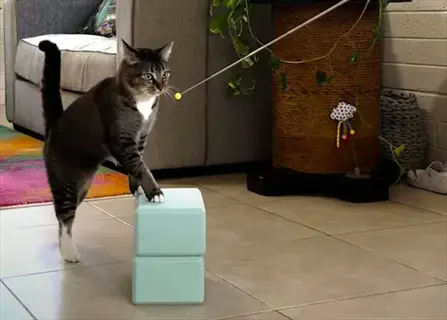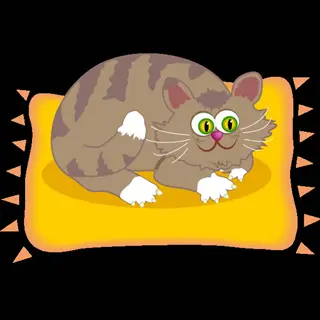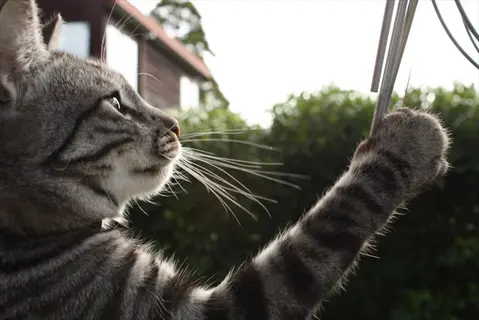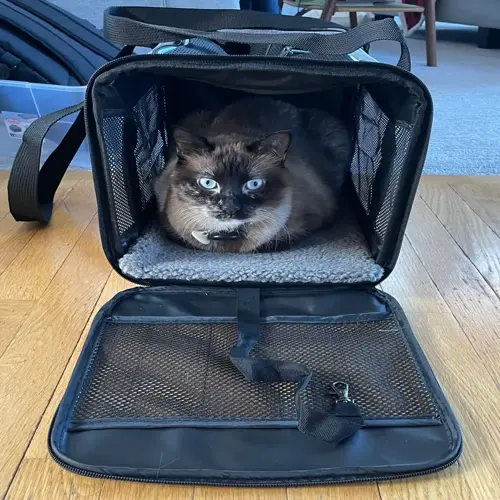Cat Clicker Training: The Complete Guide

Written by
Elin Eriksson
Reviewed by
Prof. Edward Clarke, Ph.D.Cat clicker training strengthens relationships while addressing behavioral problems, utilizing positive reinforcement principles.
The required tools are a clicker, target stick, and high-value food reward.
Fundamental techniques focus on timing and shapes behavior gradually.
Real-world solutions can redirect scratching, biting, and litter box issues.
Troubleshooting works through distraction and motivation issues using tailored strategies.
Myths are debunked that all cats can learn at any age.
Article Navigation
Using clicker training for cats completely changes how you communicate with your feline companions. Many cat owners believe that their pets are incapable of learning tricks or responding to commands. I know differently after having trained dozens of cats with this method. It is based on the principles of *operant conditioning*. The click of the clicker marks the exact point in time that the cat does the desired behavior, and the rapidity of learning is incredible.
This approach offers you three great benefits. It provides an essential mental workout to avoid boredom. Behavioral problems, such as scratching furniture, can be made manageable. Most importantly, the bond between you and your cat will be stronger. I have seen shy cats become confident in these positive sessions. We will discuss tools, techniques, challenges, and mythbusters to get you started.
Getting Started: Essential Tools & Setup
Using the right clicker helps training go more easily. I prefer ring clickers for quiet cats because they're almost silent and stay on the end of your finger. Traditional clickers are effective for basic training due to their distinct sounds. Don't pick loud ones if you have a skittish cat. You should also consider the comfort of handling the clicker. I have concluded that the best tool is one that doesn't detract their attention from the cat; otherwise, their attentions are diverted.
Use treats to fuel motivation, so arrange for their planned use. Strong-smelling treats, such as freeze-dried liver, are beneficial for the initial stages of training. Use moist foods with caution because they do slow down training. Use dry kibble in the maintenance portions of the training. Store all food rewards in odor-proof containers that you have access to near your training area. This helps build habits, as the associations included in training are established within a routine. I do have magnetic silicone pouches that can be opened without making a noise.
Timing your practice sessions will help to avoid cat frustration. Most cats are best focused in three-minute exerts, according to research. Practice before meals, as this is the period when cats are most motivated. If you see ear or tail flicking, stop immediately! In my experience, two daily practice sessions will yield better progress than one long practice session. Always remember to stop before your cat shows interest fatigue.
Space Preparation
- Select low-distraction areas away from feeding stations and litter boxes
- Use non-slip mats to define training zones and prevent sliding
- Maintain consistent lighting conditions to avoid visual distractions
- Store tools in designated cat-themed containers between sessions
Timing Protocol
- Begin with three-minute sessions twice daily before meals
- Gradually increase to five minutes as cat shows engagement
- Schedule training during high-alert periods like early morning
- Always conclude before signs of fatigue like ear flicking appear
Tool Maintenance
- Clean clickers weekly with pet-safe disinfectant to remove food residue
- Inspect target sticks monthly for loose parts that could detach
- Replace silicone pouches every six months to prevent cracking
- Rotate treat types weekly to maintain novelty and motivation
Safety Checks
- Ensure all tools have rounded edges to prevent accidental scratches
- Verify treat ingredients with veterinarian for dietary restrictions
- Position training areas away from open windows or balconies
- Monitor cats for overexertion signals like rapid panting
Progression Planning
- Start with single-surface training before introducing obstacles
- Introduce one new tool per week to prevent confusion
- Document progress in training journal with date and milestone notes
- Increase difficulty only after three consecutive successful sessions
Core Training Techniques
Begin with clicker charging to develop positive associations. For sensitive kitties, muffle the sound in a sock during the first sessions. Click, and immediately toss a high-value treat without expecting behaviors. Do this 10 times a session. I have found that desensitization typically takes about three days for most cats.
Perfect the 0.5-second timing rule for optimal shaping. Click when the paws touch the target or the hindquarters lower for a sit. Timing is more important than the complexity of the trick. Simple behaviors such as spins are lured. Natural behaviors such as stretching are captured.
Gradual fading of reinforcement helps maintain established behaviors in the long term. For example, after repeated correct responses every third time, change one reward to praise. You can also use variable reinforcement and reward only the best performances. Save special rewards, such as Churu paste, for difficult behaviors so you can more easily maintain high motivation.
Clicker Charging
- Position yourself 3 feet from cat in quiet space with high-value treats
- Click then immediately toss treat without requiring any behavior
- Repeat 10 times per session until cat looks toward treat source after click
- For fearful cats: Start with muffled clicks behind blanket at greater distance
Behavior Capturing
- Observe cat naturally performing desired action like sitting or stretching
- Click at exact moment of behavior completion (e.g., when hindquarters touch floor)
- Toss treat within 0.5 seconds to mark correct action
- Gradually shape partial attempts toward full behavior over multiple sessions
Cue Introduction
- Add verbal cue like 'sit' only after 80% success rate without words
- Say cue immediately before behavior occurs for 10-15 repetitions
- Delay treat by 1 second after click to strengthen cue association
- Practice with both verbal and hand signals for redundancy
Reward Fading
- Replace 1 of every 3 treats with praise or brief petting
- Use variable reward schedule: Treat for best performances only
- Introduce 'jackpot' rewards for complex behaviors like full roll-over
- Maintain occasional high-value rewards to prevent extinction
Troubleshooting
- If behavior stops: Return to previous successful step for reinforcement
- For distraction: Increase treat value or reduce environmental stimuli
- When progress stalls: Shorten sessions to 2 minutes maximum
- Record sessions to review timing errors between click and reward

Targeting
- Foundation Skill: Begin training sessions with nose-to-finger targeting exercises before progressing to formal target sticks for reliable recall development
- Hold your target approximately one inch from the cat's nose and consistently click-treat any observable forward movement toward the object during initial training stages
- Gradually increase the required distance over multiple sessions, requiring one to two full steps while maintaining enthusiastic engagement throughout the process
- Employ targeting strategically for recall training by deliberately placing the target near your location and generously rewarding successful approaches with high-value treats
- Progression Tip: Transition carefully to stick targets only after achieving consistent success with finger targeting across at least five separate training sessions
- Common Error: Avoid moving the target object too quickly during exercises, which could potentially frustrate cats and significantly reduce their motivation levels

Sit
- Luring Method: Hold a small treat slightly above the cat's head level and slowly move it backward over the shoulders to encourage natural sitting motion
- Click at the precise moment the hindquarters make full contact with the floor surface rather than during the descent phase of the movement for accuracy
- Phase out food lures completely after five consecutive successes by using identical empty hand motions without any treat present
- Introduce verbal cues like 'sit' only after the hand motion reliably produces consistent sitting behavior across multiple training sessions
- Duration Building: Extend sitting time incrementally before delivering rewards to gradually increase the cat's impulse control and patience levels
- Troubleshooting Tip: Reward faster during initial attempts if the cat stands immediately, then build duration more slowly with smaller time increments

Spin
- Circular Luring: Move a high-value treat in a complete circular path parallel to the floor at shoulder height to guide smooth rotational movement
- Click generously for partial quarter-turns during early sessions before requiring challenging full 360-degree rotations for reward eligibility
- Utilize walls as physical guides when necessary to prevent corner-cutting during spin attempts and maintain proper circular paths
- Differentiate clockwise and counterclockwise rotations with clearly distinct hand signals for each directional variation during training
- Motivation Tip: Reserve extra-special rewards like tuna paste exclusively for complex multi-step rotations to maintain high engagement
- Common Challenge: Decompose into smaller segments if the cat shows signs of losing interest during demanding full spin attempts

Stay
- Duration Building: Initiate training with extremely brief one-second stays before methodically increasing duration in small increments over time
- Click-treat while the cat maintains complete stillness rather than waiting until after the release command to reinforce the behavior
- Gradually increase trainer distance by stepping backward just half-step increments per session while maintaining constant visual contact
- Introduce controlled distractions like softly tossed toys only after achieving thirty seconds of reliable stationary positioning
- Release Cue: Implement a consistent verbal marker such as 'okay' to clearly signal the official end of each stay position exercise
- Foundation Requirement: Ensure solid mastery of sit or down commands before introducing challenging stay duration training components

High-Five
- Paw Targeting: Gently tap the desired paw while simultaneously saying 'high-five' before click-treating to establish clear behavioral associations
- Shape the behavior incrementally by clicking initially for minimal paw lifts off surfaces before requiring progressively higher elevations
- Raise target height gradually over multiple sessions to achieve full elbow extension and confident paw extension movements
- Utilize exclusively paw-friendly textured surfaces like carpeted platforms to encourage comfortable and enthusiastic contact behaviors
- Advanced Variation: Train distinct alternating paw movements using different auditory cues for left and right paw high-five requests
- Safety Precaution: Verify the cat demonstrates comfort with basic paw handling before attempting structured high-five training exercises
Solving Real-World Challenges
It is easy to intervene when we identify what is normal or acceptable behavior versus what we deem problematic or undesirable behavior. Scratching on Sisal is a normal part of feline maintenance. Scratching destructively on furnishings is behavior that we must curb. Counter-surfing inquisitiveness exists until it risks physical injury. I have been able to help people by having them record these problems (observational journal records).
Use positive alternatives for unwanted behaviors. Place scratch posts next to desired furniture and reward their use. To counter-surf, teach the 'go to mat' behaviors with high-quality treats. I avoid unwanted behavior by using deterrents, such as double-sided tape, on surfaces while teaching these alternative behaviors.
Desensitize cats to grooming through gradual exposure. Start with brushes and food bowls, then proceed to a second of grooming, followed by treats. I have prepared many cats for vet visits using this technique with great success and reduced stress.
Utilize individual stations in order to train multiple cats with no competition. Provide each cat with its own mat during work sessions. Alternate training times and offer the same rewards. To prevent jealousy, I ensure that all cats receive equal attention and never allow them to fight over each other's treats.
Identify Triggers
- Document behavior patterns including time of day, location, and preceding events
- Distinguish between instinctive behaviors and learned responses through observation
- Check for physical discomfort sources like arthritis or dental pain
- Consider environmental stressors such as new pets or schedule changes
Manage Environment
- Remove access to problem areas using baby gates or door closures
- Apply cat-safe deterrents like citrus sprays on furniture surfaces
- Provide appealing alternatives in accessible locations
- Use pheromone diffusers to reduce anxiety-related behaviors
Train Alternatives
- Click-reward spontaneous displays of desired replacement behaviors
- Teach 'go to mat' command for counter-surfing redirection
- Train 'scratch here' using target sticks near appropriate posts
- Build duration for calm behaviors incompatible with problems
Grooming Desensitization
- Associate tools with treats before physical contact begins
- Progress from tool presentation to light touches over sessions
- Click-reward tolerance of handling without restraint
- Gradually increase duration of handling as tolerance builds
Multi-Cat Protocols
- Train cats individually before attempting group sessions
- Use station mats to define personal spaces during training
- Provide identical high-value rewards to prevent jealousy
- Rotate cats through sessions to maintain equal attention
Troubleshooting Roadblocks
Determine whether the problem is due to motivation or technique when training stalls. If your cat won't take treats, try using a new protein source. Shrimp paste works well. If rewards work well but behaviors don't, check your timing. I've solved many cases where the click was delayed. This confused the cats.
Rescue unresponsive cats with brief training periods and control of the environment. Conduct training sessions preceding mealtime in quiet spaces where doors will be closed. If necessary, streamers or other blockages can be used to dull any outside distractions. I have found success by limiting my training to not more than ten repetitions, then discontinuing before receptiveness has waned.
Address skills loss with backward chaining. Go back to the last step your cat has already mastered. Forwards towards that impossible step and reward liberally as you gradually rebuild complexity. I once set out to teach high-fives this way after a vacation had interrupted my progress. First, ensure that you rule out any environmental distractions.
Minimize distractions through tactical adjustments. Train during quiet hours, such as early morning. Remove competitor stimuli, such as bird feeders, which are visible from windows. I use white noise machines to cover outside sounds, which break my pet cat's concentration during the sessions.
Timing Issues
- Record sessions to review delay between behavior and click
- Practice clicking within 0.5 seconds of desired action
- Use metronome apps to develop consistent timing rhythm
- Simplify behaviors if struggling with precise marking
Cue Confusion
- Verify one cue per behavior without overlapping signals
- Retrain behavior from scratch with consistent new cue
- Isolate verbal and hand signals before combining
- Ensure all household members use identical cues
Session Fatigue
- Watch for ear flicking, tail lashing as stop signals
- End sessions after 3-5 successful reps maximum
- Schedule sessions during high-alert times like dawn
- Provide water breaks during longer sessions
Regression Recovery
- Return to last successful step for reinforcement
- Increase reward value temporarily during relearning
- Reduce criteria temporarily before rebuilding
- Rule out environmental changes causing stress
Multi-Cat Dynamics
- Separate cats completely during individual sessions
- Use scent-swapping blankets between training areas
- Rotate cats through identical training sequences
- Provide distraction toys for non-participating cats
5 Common Myths
Cats are incapable of being trained because they are so independent and untrainable compared to dogs
Scientists assure us that cats have an excellent capacity for learning through operant conditioning or positive reinforcement. Their freedom makes them the perfect candidates for reward training because they willingly train for a reward. Research findings show that the brains of cats release dopamine on clicker training (as do those of dogs), thus proving their ability to form strong associations between behavior and reward, notwithstanding their independently minded natures.
While kittens can learn tricks, old cats can't learn
Cognitive research shows older cats retain their neuroplastic ability to learn throughout their lives. With the right modifications to the technique such as shorter sessions and higher value rewards, cats of any age can learn behaviors. Research on how cats learn shows that older cats have the ability to do complex behaviors better than younger kittens because they have more patience and focus than kittens who require more redirection.
All cats are frightened by clickers because of the loud unnatural noise they make
Some cats would startle at first at the sound of clickers, but with systematic desensitization, this is overcome in practically all cases. Begin to muffle the clicks by placing them in socks or using less noisy clickers thus making it necessary to click from a distance (while pairing with treats). It is noted that in approximately 3 sessions most cats make the association between the sound and reward, since studies show a 95% tolerance rate following conditioning protocols.
Training with treats always leads to weight gain and obesity
Portion control can eliminate the worry of excess weight by pointing out pea-sized treats and adjusting meal size. 10% of daily calories should be spent on training rewards with high protein options like freeze-dried chicken. Research shows that cats maintain ideal body weight when the calories contained in the treats replace those contained in regular food and not, on top making this training nutritionally neutral.
Effective training requires hour-long daily sessions to achieve meaningful results
Neuroscience studies prove cats learn most efficiently in 3-5 minute sessions matching their attention spans. Brief but consistent daily practice builds skills faster than marathon sessions causing fatigue. Documented cases show cats mastering complex behaviors like harness training through cumulative five-minute sessions, with optimal retention occurring through spaced repetition.
Conclusion
Cat clicker training is a game-changer in developing a relationship with your cat. This is achieved through a common language that uses the click as a clear marker for a "yes." In this way, frustration changes to understanding. I've seen shy cats blossom through this breakthrough in communication.
From consistent practice, you will gain three strong benefits. Destructive habits, such as scratching furniture, are under control and redirected. Your cat stays mentally stimulated and remains engaged, avoiding boredom. Most importantly, your bond grows when you give good positive experiences. This works with seniors and rescues alike.
Please don't wait any longer to start, whether your cat is young or old, and regardless of its medical history. Get a clicker and some high-value treats. Start targeting right away at the time your cat is most alert. I've been amazed at what beginners have accomplished in the first week.
External Sources
Frequently Asked Questions
Is clicker training effective for cats?
Clicker training is highly effective for cats when properly implemented. This positive reinforcement method builds trust while teaching behaviors. Studies show cats respond well to the clear sound association between actions and rewards, making it superior to punishment-based methods.
How do I start clicker training my cat?
Begin with these fundamental steps:
- Charge the clicker by clicking and immediately giving treats without commands
- Choose a quiet environment with minimal distractions
- Use high-value treats like freeze-dried chicken or tuna paste
- Keep initial sessions under three minutes
- Focus on one simple behavior like targeting before advancing
What are alternatives to clickers?
Several effective options exist if your cat fears the clicker sound:
- Verbal markers like a consistent 'yes' or 'good'
- Pen clicks or quiet snapping sounds
- Flashlights for visually-oriented cats
- Vibrating collars set to low intensity
- Consistent hand signals paired with treats
Can older cats learn clicker training?
Age is not a barrier to clicker training success. Senior cats often excel due to greater patience and focus. Adjust techniques by using higher-value rewards and shorter sessions. Focus on practical behaviors like grooming cooperation or medication acceptance for best results.
How long do training sessions last?
Optimal session length varies by cat:
- Kittens: 1-2 minutes maximum due to short attention spans
- Adults: 3-5 minutes during high-alert periods like before meals
- Seniors: 2-3 minutes with frequent breaks
- Always end before signs of fatigue like tail flicking appear
- Multiple short sessions outperform fewer long ones
What treats work best for training?
Ideal training treats share these characteristics:
- Strong-smelling options like salmon or liver paste
- Pea-sized portions to prevent overfeeding
- Soft textures for quick consumption
- Exclusive to training sessions to maintain value
- High-protein options supporting nutritional balance
How do I stop unwanted behaviors?
Redirect rather than punish using these clicker techniques:
- Teach incompatible behaviors like 'go to mat' instead of counter surfing
- Reward spontaneous good choices immediately
- Use environmental management like double-sided tape deterrents
- Address root causes like boredom with puzzle feeders
- Never use physical punishment which damages trust
Can clicker training help with vet visits?
Absolutely. Systematic desensitization prepares cats for stressful procedures:
- Train carrier entry using target sticks and rewards
- Practice handling exercises like paw touches
- Simulate exam table positions at home
- Associate medical tools with treat delivery
- Build positive associations through gradual exposure
Why does my cat ignore the clicker?
Common solutions for disengagement include:
- Rule out medical issues with veterinary checkup
- Increase treat value using novel proteins
- Shorten sessions significantly
- Muffle clicker sound for sensitive cats
- Ensure precise timing between behavior and click
How does clicker training benefit cats?
Beyond teaching tricks, clicker training provides essential advantages:
- Mental stimulation preventing boredom-related issues
- Stress reduction through predictable communication
- Stronger human-animal bonds via positive interactions
- Non-confrontational solutions to behavior problems
- Increased confidence in novel situations

